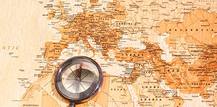Ancient World History
Students in sixth grade will continue to expand the knowledge, skills and understandings acquired in the fourth and fifth grade studies of North Carolina and the United States by connecting those studies to their first formal look at a study of the world. Sixth graders will focus heavily on the discipline of geography by using the themes of location, place, movement, human-environment interaction and region to understand the emergence, expansion and decline of civilizations and societies from the beginning of human existence to the Age of Exploration. Students will take a systematic look at the history and culture of various world regions including the development of economic, political and social systems through the lens of change and continuity. As students examine the various factors that shaped the development of civilizations, societies and regions in the ancient world, they will examine both similarities and differences among these areas. A conscious effort should be made to integrate various civilizations, societies and regions from every continent (Africa, Asia, Europe and the Americas). During this study, students will learn to recognize and interpret the "lessons of history;" those transferable understandings that are supported throughout time by recurring themes and issues.
The standards are organized around five strands: history, geography and environmental literacy, economics and financial literacy, civics and government and culture. The strands should not be taught in isolation, but woven together in an integrated study that helps understand the ancient world. Additionally, the course includes two types of essential standards – one that identifies the skills that students should master during the course of the year and another that identify the knowledge and understandings. The skills should be taught within the context of applying knowledge and understandings to a study of the ancient world.
Students in sixth grade will continue to expand the knowledge, skills and understandings acquired in the fourth and fifth grade studies of North Carolina and the United States by connecting those studies to their first formal look at a study of the world. Sixth graders will focus heavily on the discipline of geography by using the themes of location, place, movement, human-environment interaction and region to understand the emergence, expansion and decline of civilizations and societies from the beginning of human existence to the Age of Exploration. Students will take a systematic look at the history and culture of various world regions including the development of economic, political and social systems through the lens of change and continuity. As students examine the various factors that shaped the development of civilizations, societies and regions in the ancient world, they will examine both similarities and differences among these areas. A conscious effort should be made to integrate various civilizations, societies and regions from every continent (Africa, Asia, Europe and the Americas). During this study, students will learn to recognize and interpret the "lessons of history;" those transferable understandings that are supported throughout time by recurring themes and issues.
The standards are organized around five strands: history, geography and environmental literacy, economics and financial literacy, civics and government and culture. The strands should not be taught in isolation, but woven together in an integrated study that helps understand the ancient world. Additionally, the course includes two types of essential standards – one that identifies the skills that students should master during the course of the year and another that identify the knowledge and understandings. The skills should be taught within the context of applying knowledge and understandings to a study of the ancient world.

